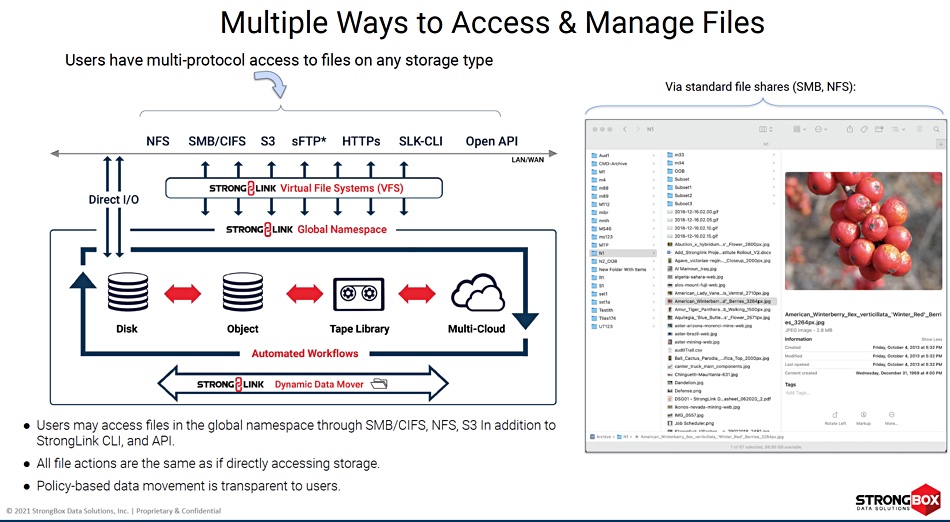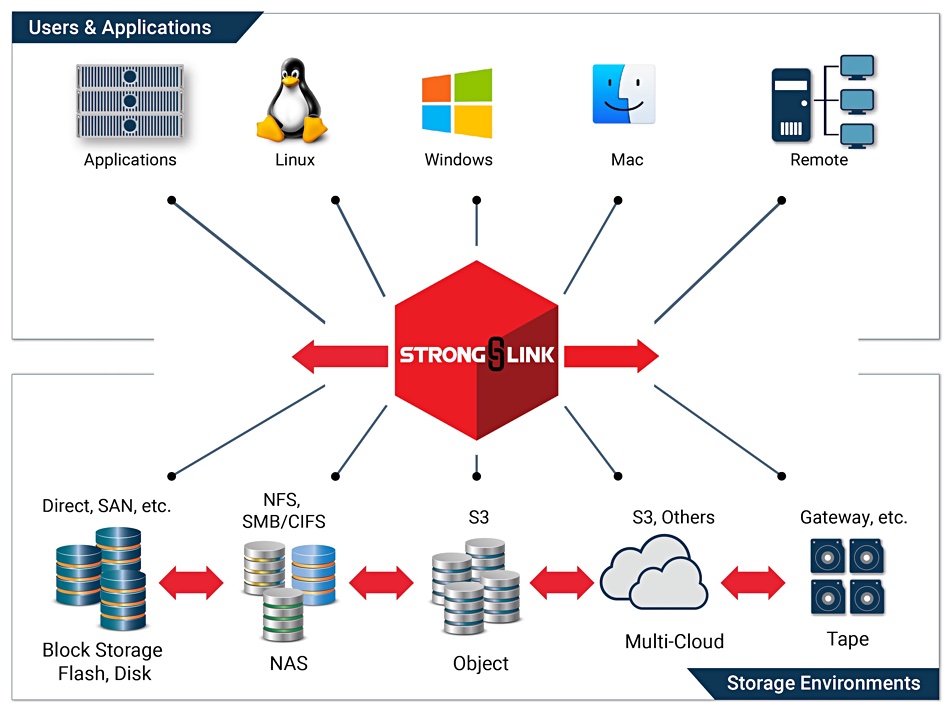StrongBox Data Solutions (SBDS) has upgraded its StrongLink software to add more performance and automation to this multi-vendor, multi-storage platform that abstracts silos into a single metadata-driven namespace.
StrongLink is an intelligent hierarchical and scale-out storage manager that manages silos as if they were in a single repository, providing policy-driven tiering between flash, disk (file, object), tape and the public cloud, migration, business continuity and disaster recovery. It can be deployed out-of-band, functioning as its own silo working with others such as Dell Isilon, NetApp and Pure. In-band deployment has it front-ending existing silos with clients accessing data through StrongLink. A hybrid deployment combines the out-of-band and in-band models in a transition period.
Floyd Christofferson, SBDS CEO, provided a canned quote: “StrongLink 3.2 brings an automated, data-centric approach to vendor-neutral storage resource management. It provides customers with crucial data intelligence plus the tools to operate across otherwise incompatible storage types from any vendor at scale.”
According to him: “The traditional data management paradigm relies on specialised storage solutions for the various stages of the data lifecycle, increasing the occurrence of data silos, vendor lock and system complexity.” StrongLink is a traditional data management silo buster, and uses a central metadata database to enable data to be indexed, ingested and accessed via a variety of protocols: NFS, SMB, S3 and LTFS, for example.

The StrongLink system is based on scale-out nodes which can be clustered (headless clustering) in a site to form so-called constellations. Constellations can be linked across sites into Galaxy systems with data replicated between them. StrongLink uses multi-threaded, parallelised operations, down to the CPU core level, across multiple nodes in a Constellation to speed performance.

Feature list
The new features in v3.2 are:
- StrongLink Galaxy gets bi-directional multi-site replication for disaster recovery (DR), collaboration, and data protection. Metadata records are replicated instantly across all sites as changes occur, and all or subsets of data are replicated asynchronously to maintain up-to-the-second data copies.
- A third-generation query engine provides expanded scale to support complex queries across hundreds of billions of files with complex metadata structures. It also provides increased performance for queries that span multiple metadata types.
- A reporting engine supports multiple report categories and the creation of new reports. An enhanced notification system monitors an expanded set of metrics, internal processes and network behaviours to provide fast, proactive alerts for system administrators.
- A StrongLink command-line interface (CLI) accommodates high-performance computing (HPC) and other workflows that typically utilise scripted procedures. It allows for creating and annotating datasets with custom metadata tags, complex queries, workflow triggers, and more.
- An open API exposes 100 per cent of StrongLink functions to give admins and users a complete selection of access utilities to better manage their data environment.
- StrongLink supports the NetCDF metadata standard for HPC and scientific workflows.
Asked how fast the new search engine is, a StrongBox spokesperson told us: “I don’t have a direct A:B apples-to-apples benchmark that I can cite. General results for similar queries are significantly faster, typically at least three to four times faster for like queries, compared with the previous query engine. But the main significance is not just snappier query performance for basic queries across a large dataset, but also the ability to do dramatically more complex queries across multiple metadata schemas without performance degradation.“
Query operations can now be parallelised to keep pace with increasing file counts in large datasets, as well as the increasing complexity across multiple schemas.
The spokesperson said: “The StrongLink CLI takes advantage of all the distributed compute [HPC customers] are used to from previous systems, but with enhanced features such as queries, metadata annotation, etc.“
Check out a product description and a datasheet to investigate StrongLink some more. Version 3.2 of StrongLink is available immediately.








